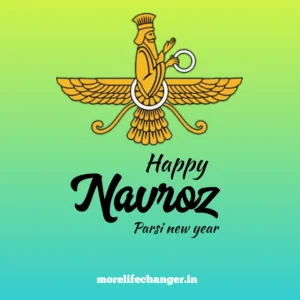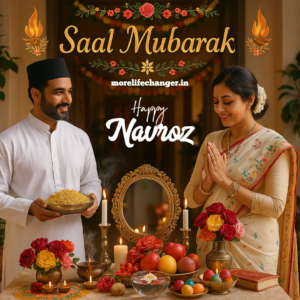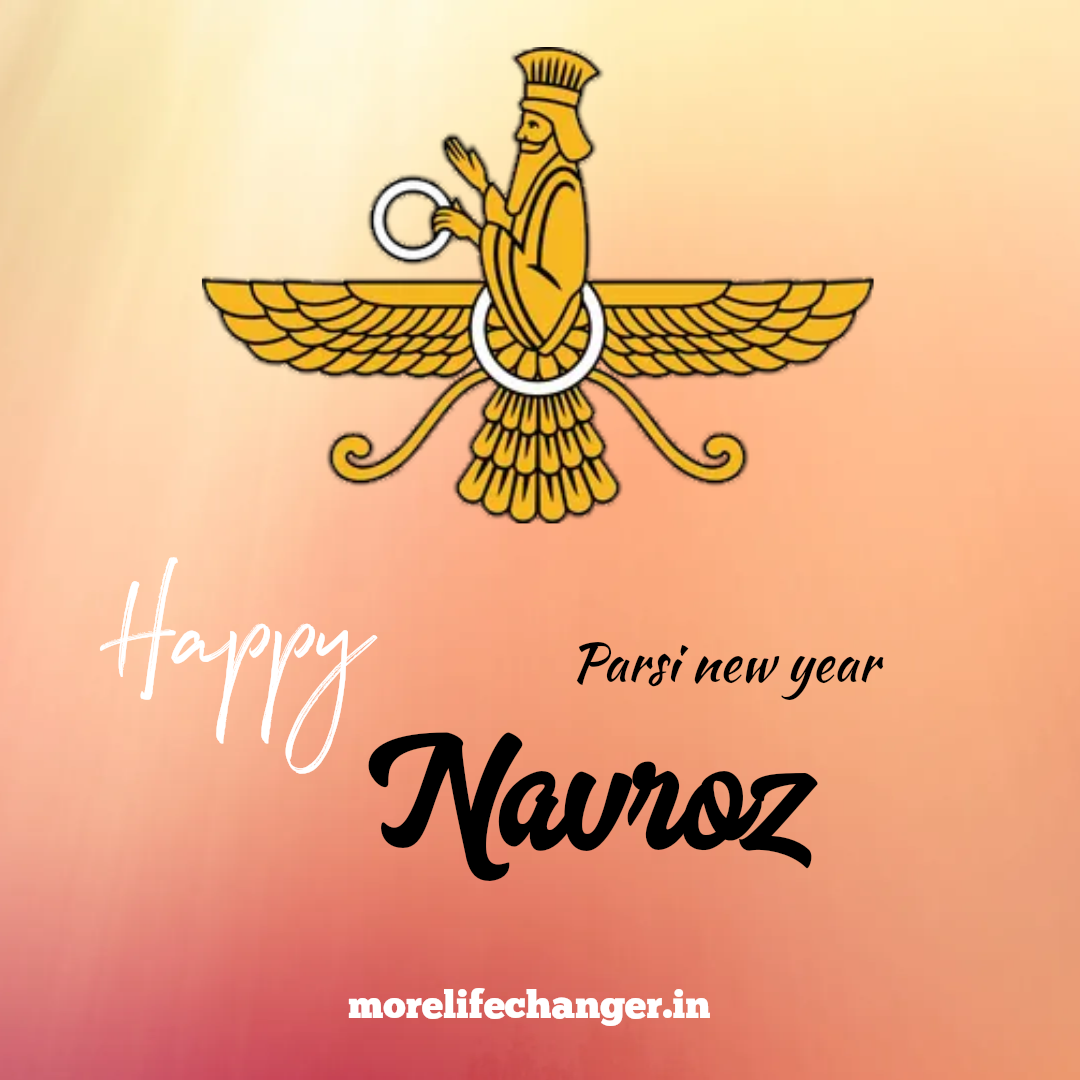Parsi New Year, also known as Navroz (or Nowruz), is the traditional New Year celebration of the Parsi community, which is a group of people who follow the Zoroastrian religion. It typically falls on the spring equinox, around March 20th or 21st each year. It is a time of renewal, reflection, and celebration, marking the beginning of a new year in the Parsi calendar.
key aspects of Parsi New Year:
Here are some key aspects of Parsi New Year:
- Religious Significance: The day celebrates the creation of the world and is a time to give thanks for the blessings of the past year while seeking peace, happiness, and prosperity for the year ahead.
- Traditions:
- Prayers and Pujas: Parsis visit fire temples to offer prayers, seek blessings, and pray for the well-being of family and community members.
- Cleaning and Decoration: Homes and places of worship are cleaned and decorated, symbolizing the idea of starting fresh in the new year.
- Feasts and Family Gatherings: Food plays a central role in the celebrations. Special dishes such as Sali Boti (a dish made with lamb and potatoes), Patra (steamed rolls), and sweets like mawa cakes are prepared.
- New Clothes: It is customary to wear new clothes to mark the new beginning of the year.
- Customs:
- Exchanging Greetings: Parsi people greet each other with “Navroz Mubarak,” which means “Happy New Year.”
- Gifts and Charity: There is also a tradition of giving gifts to friends and family members. Additionally, charity is an important aspect of the festival, as it is a time to help those in need.
- Community Celebrations: In cities with large Parsi populations, like Mumbai, India, and Karachi, Pakistan, there are public celebrations, cultural performances, and community feasts to mark the occasion.
Calendar and celebration
Zoroastrian Calendar
The Parsi New Year is based on the Zoroastrian calendar, which is a calendar system followed by followers of the Zoroastrian religion. The year is divided into 12 months, each dedicated to a particular deity or element (such as water, fire, earth). The Navroz marks the start of the year on the 1st day of Farvardin, the first month of the Zoroastrian calendar. While Navroz falls on the spring equinox, it can vary slightly depending on the local time zone.
2. Preparation of the “Hoshba” or “Jashan”
The Jashan ceremony (also called Hoshba) is a religious ceremony held to mark important occasions, including Navroz. This ceremony involves the offering of prayers, rituals, and offerings to the sacred fire. The Jashan is often conducted by the priesthood of the community. The ceremony is meant to purify the individual and the community for the new year ahead, ushering in blessings of health, prosperity, and peace.
- Sacred Fire: The sacred fire plays an important role in Zoroastrian worship, as Zoroastrians believe that fire symbolizes purity and the presence of God.
3. Traditional Foods
Food is an essential part of Navroz celebrations, and many traditional dishes are prepared for the occasion. In addition to Sali Boti (lamb with crispy potatoes), some other popular dishes include:
- Patra: Steamed rolls made from a combination of gram flour, spices, and a filling (often containing fenugreek).
- Pulao: A flavorful rice dish, sometimes served with nuts and dried fruits, symbolizing prosperity.
- Mawa Cake: A spongy, sweet cake made from mawa (milk solids) and flavored with cardamom, often garnished with nuts.
Desserts are often served in abundance, and sweets are shared with family, friends, and neighbors.

4. Symbolic Elements
- The Haft-Seen Table: While the Haft-Seen is more associated with the Persian New Year (Nowruz), there are similarities in the Parsi version of the celebration. The table often includes symbolic items, such as:
- Gold Coins: Representing wealth and prosperity.
- Fruit (like apples or pomegranates): Symbolizing health and abundance.
- Flowers: A symbol of renewal and the beauty of life.
- Mirror: A reflection of oneself, symbolizing self-reflection and introspection.
5. Charity and Acts of Kindness
As mentioned earlier, charity is a key part of the Navroz celebrations. Parsis believe in giving back to the community, especially to those in need, during the new year. Many families donate money to the poor or contribute to charitable causes. Giving to others is seen as an essential part of Zoroastrian values, which emphasize doing good deeds in this life to create a better world.
6. Parsi New Year Greetings
On Navroz, Parsi people greet each other with “Navroz Mubarak,” which is the Persian greeting for “Happy New Year.” The greeting is also commonly extended in the form of “Navroz-e Shoma Mubarak,” meaning “Happy New Year to you.” During these greetings, Parsis wish for happiness, peace, prosperity, and success in the new year for their loved ones.
7. Cultural Significance
- Unity and Community: Navroz brings the Parsi community together. People gather at temples and homes, exchange gifts, and spend time with loved ones, strengthening bonds and traditions.
- Cultural Events: In cities with significant Parsi populations, there are often performances, dances, and cultural programs that showcase the rich heritage and traditions of the Parsi community.
8. Wearing New Clothes
Much like many other cultures celebrating the new year, Parsis also wear new clothes on Navroz. It symbolizes a fresh start, a break from the past, and the idea of renewal. Traditionally, the clothes worn during the festivities are often elegant, reflecting the joy and grandeur of the occasion.
9. Global Celebration
- India: In places like Mumbai, where there is a large Parsi population, Navroz is a significant occasion, marked by community gatherings and grand meals. It’s also a time for Parsis to visit their fire temples and participate in religious ceremonies.
- Iran: Although Navroz is also celebrated in Iran (as Nowruz), the Parsi community in India and the diaspora keeps its unique traditions intact, combining Persian roots with their own Zoroastrian customs.
- Pakistan: Karachi, home to a sizable Parsi community, also celebrates Navroz with vibrant religious and cultural events, including public gatherings, prayers, and festive meals.
- Diaspora Communities: Parsi communities in countries like the UK, the US, and Canada celebrate Navroz with a sense of unity, keeping their cultural heritage alive through ceremonies, social gatherings, and religious observances.
Also read: Rongali Bihu- Assamese New Year
Parsi culture
The Parsi culture is deeply intertwined with the Zoroastrian religion and has evolved over centuries, particularly after the Parsis migrated to the Indian subcontinent from Persia (modern-day Iran) around the 8th or 10th century. Over time, they developed a unique and vibrant culture that is a blend of ancient Persian traditions and influences from India, where they settled.

Religion and Beliefs:
The Parsis follow Zoroastrianism, one of the world’s oldest monotheistic religions, which dates back to the teachings of Zoroaster (Zarathustra) in ancient Persia. The core beliefs of Zoroastrianism emphasize:
- Good Thoughts, Good Words, and Good Deeds: A central tenet of the religion, encouraging adherents to live virtuously and contribute positively to society.
- Ahura Mazda: The supreme god of Zoroastrianism, who represents wisdom, goodness, and light.
- Fire: Fire is considered sacred, symbolizing purity, and plays a central role in worship, especially in Fire Temples where Parsis go for prayers and ceremonies.
- Dualism: Zoroastrianism teaches the ongoing struggle between good and evil forces, with the ultimate goal of achieving Asha (truth and order) over Druj (falsehood and chaos).
2. Language and Literature:
- Gujarati: The primary language spoken by Parsis in India is Gujarati, which is the native language of Gujarat, the region where many Parsis settled. Parsis in Iran originally spoke Persian (Farsi).
- Literature and Poetry: Parsis have contributed significantly to literature, especially in India. Prominent figures like Sir Jamsetjee Jejeebhoy, Phirozshah Mehta, and Pheroze Chunder were key figures in the Indian independence movement and literature. Many Parsis have also contributed to the Zoroastrian scriptures and texts in the form of poetry, hymns, and philosophical writings.
3. Festivals and Celebrations:
- Navroz: As discussed earlier, Parsi New Year or Navroz is one of the most important celebrations. It marks the beginning of the new year in the Zoroastrian calendar, usually coinciding with the spring equinox.
- Khordad Sal: This is the birth anniversary of Zoroaster and is another important religious celebration for the Parsis.
- Jashan and Other Rituals: Parsis celebrate many other festivals based on the Zoroastrian calendar. The Jashan ceremony, a prayer service, is an essential part of their religious practices.
4. Cuisine:
Parsi cuisine is a unique blend of Persian, Indian, and British influences. Some staple dishes include:
- Sali Boti: A dish made of lamb cooked in a rich gravy with crispy fried potatoes.
- Patra: A steamed, spicy roll made from gram flour and fenugreek, often served with chutney.
- Pulao: A spiced rice dish, often served with meat or vegetables.
- Mawa Cake: A rich, spongy cake made with mawa (milk solids), nuts, and cardamom.
- Farcha: A Parsi-style fried chicken, often served at celebratory occasions.
- Lagan nu Custard: A creamy, sweet dessert made from eggs, milk, and sugar, flavored with rose water.
These dishes are often served during festivals like Navroz and Parsi weddings.
5. Parsi Architecture:
Parsi architecture has a distinctive style that blends traditional Persian designs with influences from British and Indian architectural styles.
- Fire Temples: The Agiyari (Fire Temple) is a place of worship where Parsis gather for prayers. The temples often have a distinct architectural style, featuring large domes and intricate carvings.
- Bungalows and Mansions: Many Parsi homes, especially in Mumbai, are characterized by spacious bungalows with large gardens. These homes often have a blend of Victorian and Persian influences in their design.
- Towers of Silence (Dakhmas): This is one of the most unique aspects of Parsi culture. Towers of Silence are circular, elevated structures used for the traditional Parsi method of disposing of the dead, where bodies are left to be consumed by vultures. This practice is rooted in Zoroastrian beliefs about the sanctity of fire and earth.
6. Dress and Attire:
- Traditional Parsi Clothing: Parsi women often wear the sari, but with a unique twist. The Parsi sari is worn with a jacket-like garment called a “chador” over the sari. It’s a symbol of modesty and tradition. Men typically wear Western-style suits, but older generations may wear Kurta-Pajama or a Sherwani on formal occasions.
- The Parsi Cap: The “Topi” (cap) is another key element of traditional Parsi dress. It is typically worn by men, especially during religious ceremonies and festivals.
7. Social Contributions and Influence:
Over the years, Parsis have made significant contributions to various fields such as business, science, art, and literature. Some notable Parsi individuals include:
- Jamsetji Tata: The founder of the Tata Group, one of India’s largest industrial conglomerates.
- Phiroze Mehta: A prominent social and political leader who played a key role in the Indian freedom movement.
- Freddie Mercury: The iconic lead singer of Queen, born Farrokh Bulsara, was of Parsi descent.
- Ratan Tata: A contemporary industrialist and philanthropist, and the chairman of the Tata Group.
- J.R.D. Tata: An aviator and industrialist, and the first person to fly in India.
8. Zoroastrian Ethics:
Parsis hold strong ethical values rooted in Zoroastrian teachings. The most well-known ethical principle is the Threefold Path:
- Humata (Good Thoughts)
- Hukhta (Good Words)
- Hvarshta (Good Deeds)
These principles guide their daily lives and interactions with others. Parsis are known for their dedication to social justice, education, and philanthropy.
9. Community and Family:
The Parsi community is relatively small, with an estimated population of around 100,000 worldwide, most of whom live in India (especially Mumbai) and Iran. Despite being a small community, the Parsis have maintained a strong sense of unity and identity. Family plays an essential role in Parsi culture, and traditional values emphasize respect for elders, hospitality, and close-knit relationships.
10. Challenges and Preservation of Culture:
The Parsi community has faced challenges in terms of population decline due to a low birth rate, interfaith marriage, and migration. Many Parsis have relocated abroad for better opportunities. Despite these challenges, the community remains proud of its rich cultural heritage and works to preserve its traditions through cultural institutions, educational programs, and community outreach.
In summary, Parsi culture is a fascinating and vibrant blend of ancient traditions, religious practices, and modern influences. It is a culture that values education, charity, and respect for tradition while also embracing change and progress. The Parsis have made significant contributions to the countries they have settled in, particularly India, and their influence can be seen in many aspects of society, from business to the arts.
Please join discussion on Facebook about world facts and its secret .

